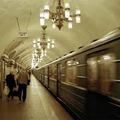 On Friday evening, at 8pm, out train departed from Yekaterinburg to Tobolsk. The train's final destination was Nizhnevartovsk (Нижневартовск), and a few hours after Tobolsk it also stopped to Surgut, which might sound familiar for Hungarians as SurgutNetf had shares in MOL, the Hungarian oil company 2-3 years ago. According to the wikipedia, "Nizhnevartovsk is the center of the West Siberian oil-producing region and one of the wealthiest cities in the country". And, according to Julia, a huge prison works there. So the wealthy residents of Nizhnevartovsk probably fly, because on the train we mostly saw people who we could imagine easily as former or future prisoners, or friends of prisoners. But i have to mention that although it was their look, their behaviour was absolutely normal, even if not as firendly as it is usual on train in Russia. The (also prisoner-looking) guy with whom Julia was talking for a minute maybe, said that in Nizhnevartovsk there are a lot of Northern Americans working, for very good money. In textile industry ... of course not, in the oil one. :)
On Friday evening, at 8pm, out train departed from Yekaterinburg to Tobolsk. The train's final destination was Nizhnevartovsk (Нижневартовск), and a few hours after Tobolsk it also stopped to Surgut, which might sound familiar for Hungarians as SurgutNetf had shares in MOL, the Hungarian oil company 2-3 years ago. According to the wikipedia, "Nizhnevartovsk is the center of the West Siberian oil-producing region and one of the wealthiest cities in the country". And, according to Julia, a huge prison works there. So the wealthy residents of Nizhnevartovsk probably fly, because on the train we mostly saw people who we could imagine easily as former or future prisoners, or friends of prisoners. But i have to mention that although it was their look, their behaviour was absolutely normal, even if not as firendly as it is usual on train in Russia. The (also prisoner-looking) guy with whom Julia was talking for a minute maybe, said that in Nizhnevartovsk there are a lot of Northern Americans working, for very good money. In textile industry ... of course not, in the oil one. :) The train arrived at 6am to Tobolsk, being zero minutes late of course, on the peron there were a lot of pavilons selling different food and alcohol products to those travelling further to the western siberian oil fields, to Surgut or to Nizhnevartovsk. The railway station is 10kms away from the city, this is because the railway is on the left side of the river Irtish, and near Tobolsk, which is on the right side, the river is wide, so they made railway bridge 10 kms further north, where it is more narrow. The view from the railway bridge is always cool, now specially, as the Irtish is forzen. Btw the name Tobolsk is after the river Tobol, which starts 1-2kms south from the city, as a branch of Irtish.
The train arrived at 6am to Tobolsk, being zero minutes late of course, on the peron there were a lot of pavilons selling different food and alcohol products to those travelling further to the western siberian oil fields, to Surgut or to Nizhnevartovsk. The railway station is 10kms away from the city, this is because the railway is on the left side of the river Irtish, and near Tobolsk, which is on the right side, the river is wide, so they made railway bridge 10 kms further north, where it is more narrow. The view from the railway bridge is always cool, now specially, as the Irtish is forzen. Btw the name Tobolsk is after the river Tobol, which starts 1-2kms south from the city, as a branch of Irtish.So we were not sure how easily we can get to the city, but after 2-3 mins wait, a marshrutka came taking us to Kremlin. When we arrived, we realized that it wasn't the best idea to go to Kremlin at 6:45am, as it is of course closed, and moreover, it is -5 degrees, what was quite shocking after the +10 at Yekaterinburg the day before. So the trip did not start very well, it took us one and a half hour to find a cafe against the cold, as the town was died out. The only help in the situation was that in the city center buses ran very often, and ticket is 13 roubles (30 euro cents), so we used buses as heaters until we found a cafe. The good side of it was that we saw the old town from bus #3, with a lot of nice wooden houses.
 After warming up at the café, the weather also turned sunny, the snow melted to it was plus during the day. We went back to Kreml, where we walked around, and then visited the museum dedicated to the history of western siberia. It was quite interesting, and huge. In the 18th and 19th century, the Russian Empire was divided into 8 governorates. Tobolsk was the capital of the siberian one, the biggest one, the tsars also visited Tobolsk often to meet the actual Governator. Another interesting fact (it sticked to my mind) is that Mendeleev, the creator of the periodic system of elements, was born here, although did not spend his active year in Tobolsk.
After warming up at the café, the weather also turned sunny, the snow melted to it was plus during the day. We went back to Kreml, where we walked around, and then visited the museum dedicated to the history of western siberia. It was quite interesting, and huge. In the 18th and 19th century, the Russian Empire was divided into 8 governorates. Tobolsk was the capital of the siberian one, the biggest one, the tsars also visited Tobolsk often to meet the actual Governator. Another interesting fact (it sticked to my mind) is that Mendeleev, the creator of the periodic system of elements, was born here, although did not spend his active year in Tobolsk.Nowadays, Tobolsk is not as important as it used to be, it's just a small town in Tyumen oblast, mainly just with turistic importance, thanks to its Kremlin. It has many trains a day from Yekaterinburg and Omsk, but it's not hard to see that those trains primarily serve the western siberian oil towns in the north, and they just stop by Tobolsk to load/unload a few passengers. Also in the railway line a lot of oil wagons are bing transported by the diesel locomotives (the line is not electrified).
After the museum we just took a walk around Kemlin, as the view on Irtish is fantastic and the Kremlin is high. An interesting thing is that a small part of the town lies on the other side of the Irtish, and a road on the ice leads there, but now it was closed as spring is coming. But for pedestrians it was still open, as using a palling, they can safely walk with decreased pressure on the ice and without getting wet from the water on the melting ice. In the summer, a ferry operates, and in between, e.g. now, when the ice is not thick enough for crossing by car/bus, but thick enough for preventing the ferry from operating, there is no transport to this 20-30 houses, except for going to the rail bridge 10kms northwards. When the ice route is open, one bus line is extended through Irtish to this village.
We were a bit afraid that transport can be unpredictable to the station as it is far, so we went there well in time, although transport is fact is better than is Yekat, as there is timetable(!) for everything, not just approximate intervals. And in our experience, they do follow the timetable, even marshrutkas do.
 The train ride back to Tyumen (Tyumen is on the way to Tobolsk, Tyumen is on the Trans-Siberian main line, Tobolsk is not, the Nizhn. branch starts in Tyumen) was quiet, we half-slept, but as we did not book linen, we did not fully lie on our place. The way was just 4 hours, but we felt like we arrived from winter to summer, already when getting near Tyumen sun shined in the window, and snow was nowhere.
The train ride back to Tyumen (Tyumen is on the way to Tobolsk, Tyumen is on the Trans-Siberian main line, Tobolsk is not, the Nizhn. branch starts in Tyumen) was quiet, we half-slept, but as we did not book linen, we did not fully lie on our place. The way was just 4 hours, but we felt like we arrived from winter to summer, already when getting near Tyumen sun shined in the window, and snow was nowhere. Our Couchsurfing host, Olga was waiting for us at the station, we went to the enbankment of river Tura (also branch of Irtish), where many people were biking, roller skating, walking. The river was not frozen, but huge ice plates were floating on it. It's not so wide and there are a lot of bridges over it. Then we went to the center where there is a newly built huge park and a circus, with entertainment park and monuments. It was really nice area, our first impressions of Tyumen were good. Olga lives not far from the center, in a new, modern apartment, and most importantly she has 2 very kind and active snails. So in the evening there were the following activities: chatting, washing the snails (Olga let us to do it), and playing Italian cards.
Our Couchsurfing host, Olga was waiting for us at the station, we went to the enbankment of river Tura (also branch of Irtish), where many people were biking, roller skating, walking. The river was not frozen, but huge ice plates were floating on it. It's not so wide and there are a lot of bridges over it. Then we went to the center where there is a newly built huge park and a circus, with entertainment park and monuments. It was really nice area, our first impressions of Tyumen were good. Olga lives not far from the center, in a new, modern apartment, and most importantly she has 2 very kind and active snails. So in the evening there were the following activities: chatting, washing the snails (Olga let us to do it), and playing Italian cards. On Sunday we went to see a museum, about life in Tyumen in 19th-early 20th century and about civil war in western siberia (first was the larger part). It was quite interesting, was a good idea to go there. Then we took a long walk in the city, seeing all interesting places and having a long chat, and taking a lot of pictures. Tyumen is a center for oil and gas business, all big russian oil companies are present here, there is a huge "Tyumen State Oil and Gas University", and a lot of different institutes and authorities realted to oil and gas. Gazprom also has a huge glass-building in the center. Tyumen oblast is the richest one, and the 3rd biggest one as it's northern end is the north sea. Therefore, eskimos also live in this oblast, donno if they are also very rich or not. But at least they can get cheap oil :)
On Sunday we went to see a museum, about life in Tyumen in 19th-early 20th century and about civil war in western siberia (first was the larger part). It was quite interesting, was a good idea to go there. Then we took a long walk in the city, seeing all interesting places and having a long chat, and taking a lot of pictures. Tyumen is a center for oil and gas business, all big russian oil companies are present here, there is a huge "Tyumen State Oil and Gas University", and a lot of different institutes and authorities realted to oil and gas. Gazprom also has a huge glass-building in the center. Tyumen oblast is the richest one, and the 3rd biggest one as it's northern end is the north sea. Therefore, eskimos also live in this oblast, donno if they are also very rich or not. But at least they can get cheap oil :) In Tyumen there are a lot of nice, well-preserved parks, statues, new buildings, it's nice to walk around. There are two main roads, paralel to each other and both one-way, the road of Rapublic and the Lenin road, if you walk along these, you see everything interesting, although they are long. And the railway station, which is also modern and clean, is 10 mins walk from the middle part of Lenin road. Julia bought some local newspapers for the way back to Yekat, i just expected to eat, drink tea, and sleep (as we had linen booked for this one). The train was blue by Belorussian Railway, coming from Irkutsk and going to Minsk, for most of our travel mates our presence (five and a half hours) was just an eyeblink. We slept a bit, Julia read the newspapers and watched a film on netbook, I made tea. Btw almost forgot: Olga had cool tasty tea straight from China (a friend brought it).
In Tyumen there are a lot of nice, well-preserved parks, statues, new buildings, it's nice to walk around. There are two main roads, paralel to each other and both one-way, the road of Rapublic and the Lenin road, if you walk along these, you see everything interesting, although they are long. And the railway station, which is also modern and clean, is 10 mins walk from the middle part of Lenin road. Julia bought some local newspapers for the way back to Yekat, i just expected to eat, drink tea, and sleep (as we had linen booked for this one). The train was blue by Belorussian Railway, coming from Irkutsk and going to Minsk, for most of our travel mates our presence (five and a half hours) was just an eyeblink. We slept a bit, Julia read the newspapers and watched a film on netbook, I made tea. Btw almost forgot: Olga had cool tasty tea straight from China (a friend brought it).In the evening after the 22:38 arrival to Yekat, we were a bit afraid of how will we get home, but a marshrutka was immediately coming, we even had to run to catch it, so record fast, in 35 mins we were at home from railway station.
Conculsions of the trip:
i never go to Nizhnevartovsk if i am not forced
siberia is cold, even in April
Tobolsk early morning is not full of surprises
They build nice parks in Tyumen from EU's high fuel prices
chinese tea is good
sometimes Yekat's transport can provide positive surprise
Overall rating of the trip from one to five: 5, overall rating of Tobolsk early morning: 1 (and i wasn't strict)







